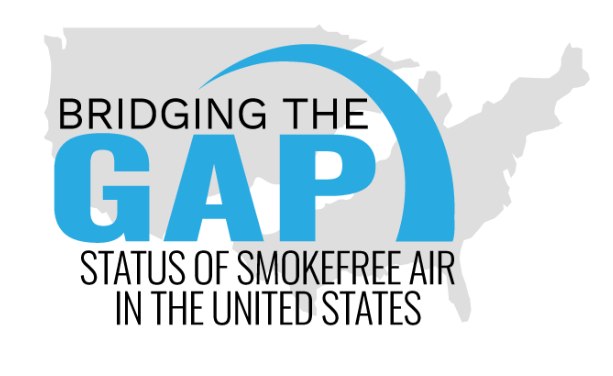more than 75% of the state's population is unprotected
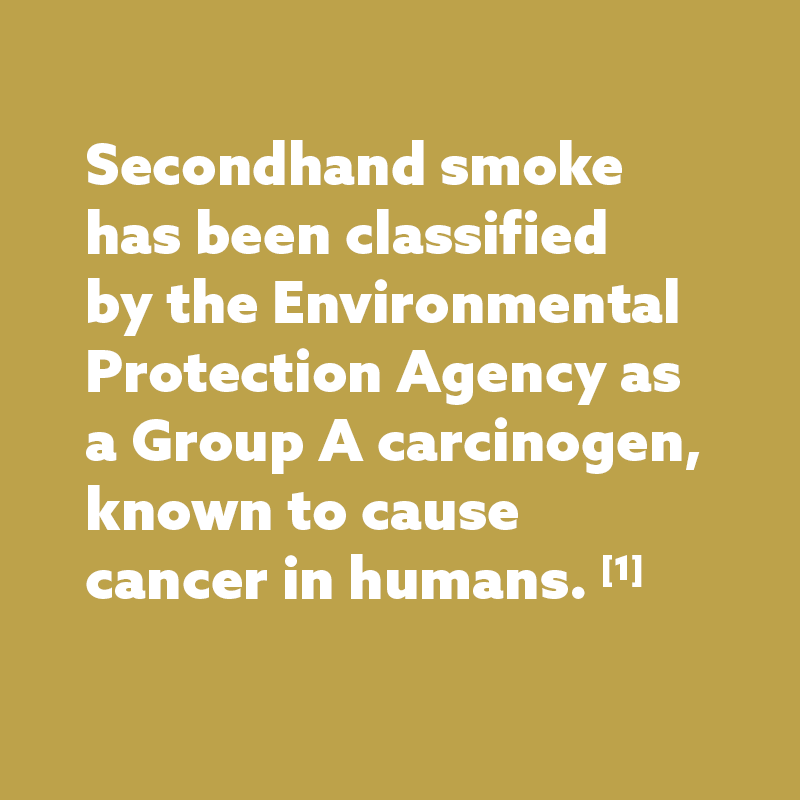
Nearly two decades have passed since Georgia adopted a weak law that prohibits smoking in some enclosed public places and workplaces. Smoking is still allowed in restaurants and bars that do not admit or employ people under 18, among other indoor environments. Strong local ordinances in recent years have brought the percentage of Georgians protected by a 100% smokefree workplace, restaurant, and bar law up to 23%. However, with a population that exceeds 10.5 million people, there are still millions of Georgians still exposed to secondhand smoke in indoor spaces. More than 75% of the state’s population is unprotected.
- 61% of Americans enjoy comprehensive smokefree protections in all public places and workplaces, including restaurants and bars. In contrast, in Georgia, only 23% of the population is protected by this type of smokefree law. [2]
- 204,000 Georgians currently under the age of 18 are projected to die of tobacco-related disease. [3]
- Smoking costs $3.18 billion in annual health care costs and an estimated $3.17 billion in lost productivity. [4]
- Georgia is 1 of 10 “Most Challenged” states based on the United Health Foundation’s “America’s Health Rankings Annual Report,” ranking 38th out of 50 and 39th for Non-smoking Regulations. [5]
- Closing smokefree gaps would reduce exposure to the hazards of secondhand smoke and increase health equity by providing healthy smokefree indoor air to all individuals.
Preemption Status:
Not Preempted
State law does not preempt local governments from adopting smokefree air laws. Preemption refers to situations in which a law passed by a higher level of government takes precedence over a law passed by a lower one. In such cases, preemptive state laws set a ceiling, rather than a floor, and do not allow local authorities to enact strong local laws.

Almost Everyone is Exposed to Secondhand Smoke in Georgia
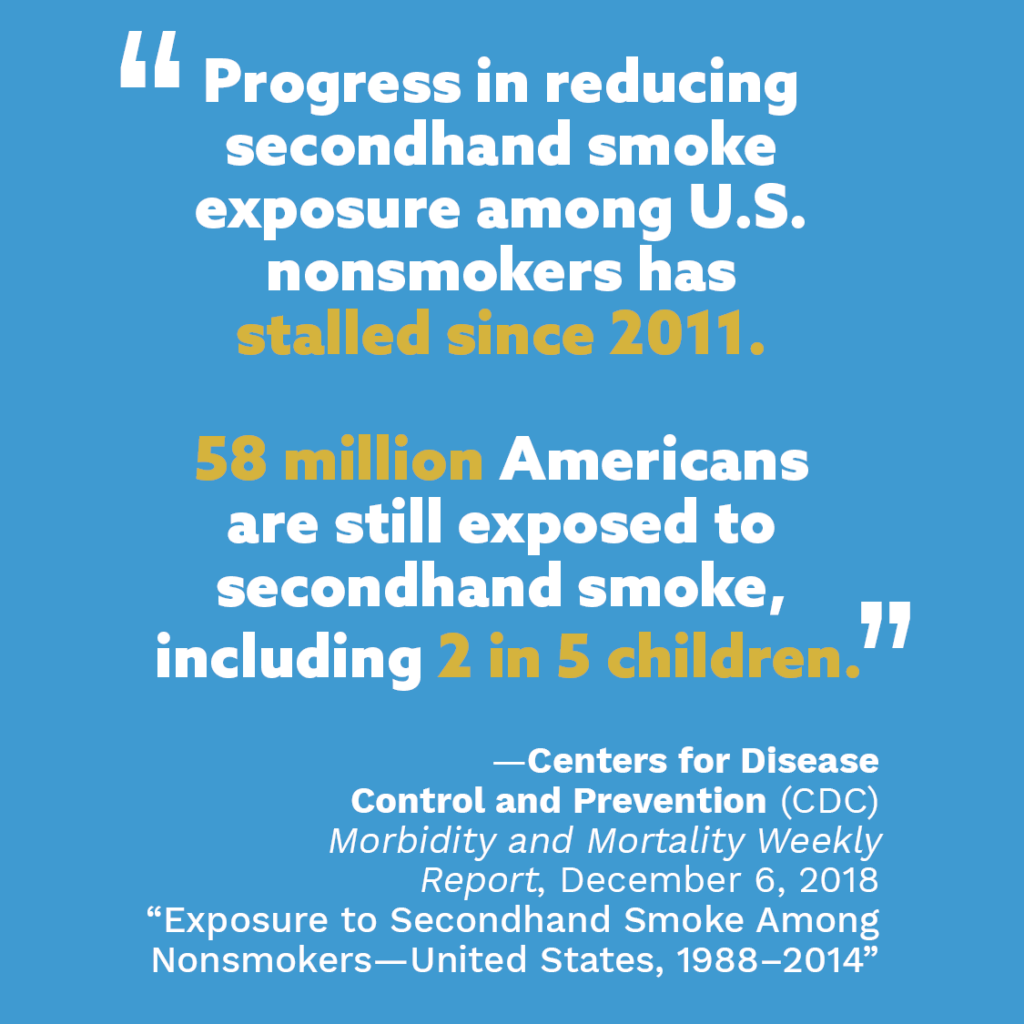
Current Landscape of Smokefree Protections
100% Smokefree Workplace, Restaurant, and Bar Laws, as of December 2022 [2]
Click on any star for city name.
To see additional smokefree laws, visit our list.
Smokefree progress stalled in Georgia following the passage of the weak Georgia Smokefree Air Act in 2005. In a 15-year span, only three municipalities successfully implemented comprehensive smokefree ordinances in Savannah, Augusta, and Chatham County. Fortunately, a resurgence of interests and resources in recent years has reignited local advocacy efforts resulting in growing momentum in the state. Recent successes in Atlanta, Gwinnett County, City of South Fulton, and Doraville have helped to bring comprehensive smokefree protections to the workers, residents, and visitors in these communities. Nevertheless, the exemptions created by the 2005 Georgia Smokefree Air Act continue to reinforce the conditions that foster disparate health outcomes, such as heart and respiratory diseases, strokes, and cancer – which account for 4 of the top 5 causes of death in Georgia. Smokefree protections are trending up in Georgia and that is incredibly encouraging.
With the enactment of recent comprehensive ordinances, the percent of Georgia’s population protected from exposure to secondhand smoke increased to 23%

Who is Left Behind?
Slow progress means continued exposure for millions of Georgians; 90.1% of Georgia’s population is still exposed to secondhand smoke in workplaces, restaurants, and bars. African Americans and Hispanics make up approximately 41% of Georgia’s population and are the most vulnerable to workplace exemptions.
While many establishments have adopted voluntary smokefree policies, those trends favor the metro regions throughout the state. Rural populations disproportionately represent Georgia’s most disparate public health outcomes. Access to care continues to be a challenge as communities are losing resources and capacity to provide adequate services, including closures of rural health centers and the reduction of the number of medical professionals in the region. The absence of healthy, smokefree workplaces for every worker doubles down on the social determinants of health for Georgia’s most marginalized residents. Georgia Smokefree Air Act of 2005 gives a smokescreen of protections for the state’s workforce as blue collar and hospitality industry employees often suffer in silence, working in the forgotten establishments exempted by the state’s partial protections.
Poor Health Outcomes and High Costs
Tobacco use is the leading preventable cause of death in the United States. More than 480,000 people die from smoking or exposure to secondhand smoke each year. [3]
In Georgia, the smoking rate among adults is 15.8% and 4% for high school students, compared to national rates of 14% and 8%, respectively. Tobacco exacts a high toll in Georgia: 11,700 Georgians die each year of tobacco-related illness, and annual health care costs in the state directly caused by tobacco use are $3.18 billion. [4]
Secondhand smoke exposure is a risk factor for a many of the most life-threatening chronic illnesses, including heart disease, hypertension, respiratory disease, stroke, and cancer. It is also a contributor to respiratory disease, ear infections, sudden infant death syndrome, more severe and frequent asthma attacks, and slowed lung growth in children. [3,6]
Beyond secondhand smoke exposure, nonsmokers exposed to thirdhand smoke in a casino are at an ever higher risk than those in a thirdhand smoke-polluted home. [7] Further, hospitality workers and children are susceptible to thirdhand smoke exposure, as the particles cling to hair, clothing and cars. Young children are particularly vulnerable, because they can ingest tobacco residue by putting their hands in their mouths after touching contaminated surfaces. [8]
Smokefree laws help to reduce adult smoking prevalence and prevent youth and young adult smoking initiation. [3,6]

Entertainers, bar staff, and hospitality employees are exposed to secondhand smoke in most venues throughout Georgia
Gaming in Georgia
Georgia does not currently have state regulated gaming venues, however numerous casinos are proposed for the state. Any future casinos for the state would be workplaces and public places and should be smokefree. There is at least one cruise casino based in Georgia, but the casino operates in international waters and is not subject to state law. See the ANR Foundation Smokefree Casinos and Gaming Property Directory for Georgia.
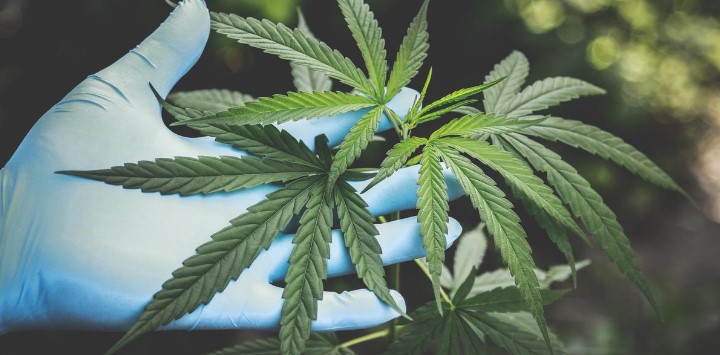
New Potential Challenge: Secondhand Marijuana Smoke
In April 2019, the Georgia legislature approved a bill to allow in-state cultivation of cannabis and the sale of the low-THC oil. While readiness for recreational marijuana among statewide elected officials remains low, public health and smokefree advocates should prepare for increasing pressure from the cannabis industry to increase access to various forms of marijuana. Secondhand marijuana smoke and vapor is a health hazard for nonsmokers. Just like secondhand tobacco smoke, marijuana smoke is a potent source of PM 2.5 fine particulate matter. Marijuana secondhand smoke impacts cardiovascular function; it contains thousands of chemicals and at least 33 carcinogens.
Public Health Advocates are Fighting for Health Equity
Health equity requires an investment of time and money.
COVID Reminds Us That Health Promotion Policies Matter
Smoking and vaping, along with exposure to secondhand smoke and aerosols, negatively impact the respiratory system and may cause a person’s immune system to not function properly, known as being immunocompromised. Research demonstrates that current and former smokers of any age are at higher risk of severe illness from coronavirus disease (COVID) in part due to compromised immune and/or respiratory systems. Smoking leads to cardiovascular disease, as well as respiratory illnesses including bronchitis, asthma, Chronic Obstructive Pulmonary Disease (COPD), and lung cancer as a result of exposure to particulate matter, toxins, and carcinogens into their lungs. Secondhand tobacco and marijuana smoke and aerosol contain many of the same toxins, carcinogens, and particulate matter that lead to respiratory and cardiovascular diseases.
Removing masks to smoke or vape indoors undermines the proven benefit of face coverings and increases the risk of transmitting or inhaling COVID via infectious respiratory droplets, uncovered coughs, and increased touching of faces. Preventing exposure to secondhand smoke and e-cigarette aerosol or vape by adopting a smokefree policy with no smoking or vaping indoors and moving smoking or vaping to socially distanced outdoor areas away from entrances, could help mitigate worker and public exposure to carcinogens and toxins, as well as COVID.
Just as social distancing and handwashing help prevent the spread of disease, eliminating secondhand smoke is critical to prevent acute and chronic diseases, and saves lives by reducing the risk of heart disease, stroke, respiratory diseases, and lung cancer by up to 30% at a population wide level.
Going smokefree prevents exposure to the carcinogens and toxins in secondhand tobacco and marijuana smoke as well as dramatically reduces the spread of respiratory droplets that could transmit flu and other viruses like COVID.
Strategies to Close Gaps & Increase Health Equity
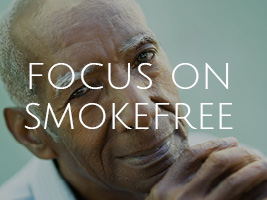
Focus on smokefree policies: Competing issues can distract and delay work on smokefree policies. Smokefree laws have immediate and long-term health and economic benefits, and they are worth the investment of time and effort to protect everyone from exposure to a known human carcinogen. [3] Strengthening the statewide smokefree law will require highly organized, concentrated efforts to build decision maker support and create a sense of urgency to act to make all workplaces smokefree.

Let local lead the way: Since Georgia municipalities have the authority to adopt local laws, communities should focus on local laws covering all workplaces, including bars and gambling facilities.
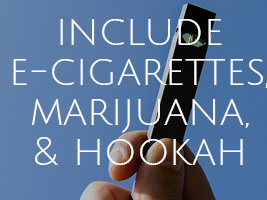
Electronic cigarettes (e-cigarettes), marijuana, and hookah should be included in smokefree laws: Smokefree laws should also prohibit the use of e-cigarettes, marijuana, and hookah to prevent secondhand smoke exposure to the toxins, carcinogens, fine particles, and volatile organic compounds that have been found to compromise respiratory and cardiovascular health. [9,10]

Thwart preemptive efforts: With the recent success of local laws in neighboring states like Louisiana, Mississippi, and Texas, the tobacco industry and its allies are eager to block the wave of momentum from spreading to Georgia. Public health advocates can expect to see more aggressive attempts by the opposition to promote preemptive legislation in the Capitol. Preemptive laws typically contain a few very weak provisions and prevent further progress at the local level where stronger laws are more likely to pass. Thwarting preemptive efforts will require vigilance from the public health community and its allies in order to preserve the landscape for local smokefree policy progress.
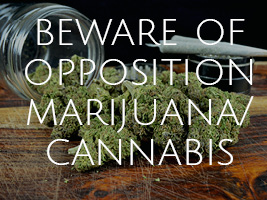
Beware of opposition from cannabis/marijuana proponents: The Georgia legislature legalized the sale of the low-THC oil in 2019. States that legalize medical marijuana typically go on to legalize recreational, adult use marijuana after a few years. Marijuana smoke is also a form of indoor air pollution and a hazard to nonsmokers’ health. In order for indoor workplaces and public spaces to truly be safe and healthy environments, tobacco and marijuana smoke, along with secondhand e-cigarette aerosol/vapor should be prohibited.

Invest in the future by increasing funding and resources: In order to address the gaps in smokefree coverage and build momentum across the state, a great deal of effort and financial resources will be needed to explain the ongoing disparities in smokefree protections and the benefits of 100% smokefree environments, as well as to counter misinformation about the ability of ventilation systems to protect people from secondhand smoke exposure.

Strengthen power of partnerships: Building upon the growing momentum for smokefree policies throughout the state will require investment and engagement of an array of partners. Each community is different and each campaign should reflect a diversity of individuals and organizations that represent the whole. Emphasizing the importance of smokefree policy change to partnerships built with organizations and stakeholders across the state will continue to build power for strengthening the statewide smokefree law.
The people of Georgia deserve to work, play, and live in smokefree air

Sources of data:
1. “U.S. Environmental Protection Agency, Respiratory Health Effects of Passive Smoking: Lung Cancer and Other Disorders,” EPA/600/6-90/006F, December 1992.
2. American Nonsmokers’ Rights Foundation. (2021). U.S. Tobacco Control Laws Database. Berkeley, CA.
3. US Department of Health and Human Services. The health consequences of smoking: 50 years of progress. A report of the Surgeon General. Atlanta, GA: US Department of Health and Human Services, CDC; 2014.
4. Centers for Disease Control and Prevention. (n.d.). State Highlights: Georgia [from State Tobacco Activities Tracking and Evaluation System].
5. United Health Foundation. (2021). America’s Health Rankings Annual Report.
6. US Department of Health and Human Services. Preventing tobacco use among youth and young adults. A report of the Surgeon General. Atlanta, GA: US Department of Health and Human Services, CDC; 2012.
7. Matt, Dr. Georg (2018). Smoking Bans May Not Rid Casinos of Smoke. US News and World Report.
8. Matt, G E, Quintana PJ E, Hovell MF et. al. (2004). Households contaminated by environmental tobacco smoke: sources of infant exposures. British Medical Journal: Tobacco Control.
9. Grana, R; Benowitz, N; Glantz, S. “Background Paper on E-cigarettes,” Center for Tobacco Control Research and Education, University of California, San Francisco and WHO Collaborating Center on Tobacco Control. December 2013.
10. Williams, M.; Villarreal, A.; Bozhilov, K.; Lin, S.; Talbot, P., “Metal and silicate particles including nanoparticles are present in electronic cigarette cartomizer fluid and aerosol,” PLoS ONE 8(3): e57987, March 20, 2013.2
Related Reading:
Huang, J., King, B.A., Babb, S.D., Xu, X., Hallett, C., Hopkins, M. (2015). Socio-demographic disparities in local smoke-free law coverage in 10 states. American Journal of Public Health, 105(9), 1806–1813.
Tynan, M.A., Baker Holmes, C., Promoff, G., Hallett, C., Hopkins, M., & Frick, B. (2016). State and local comprehensive smoke-free laws for worksites, restaurants, and bars — United States, 2015. Morbidity and Mortality Weekly Report, 65(24), 623-626.
American Gaming Association. (September 2018). State of the States: The AGA Survey of the Casino Industry.
[n.a.], “Tobacco industry interference with tobacco control,” Geneva: World Health Organization (WHO), 2008.
NCI Monograph 17: Evaluating ASSIST – A Blueprint for Understanding State-level Tobacco Control Evaluation of American Stop Smoking Intervention Study for Cancer Prevention Chapter 8, Evaluating Tobacco Industry Tactics as a Counterforce to ASSIST (October 2006).
July 2022

